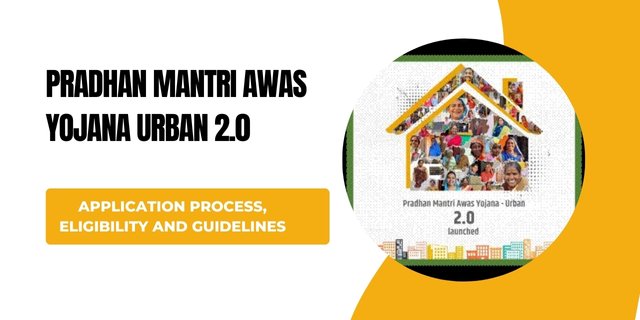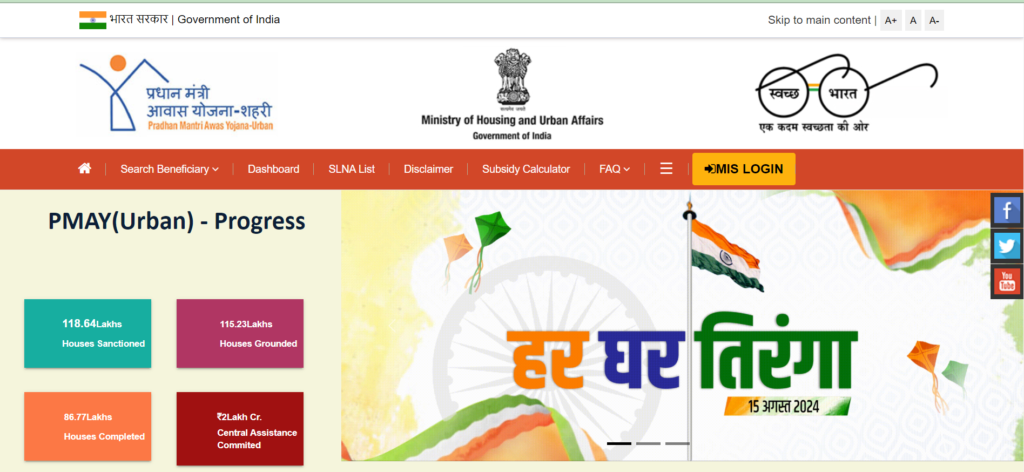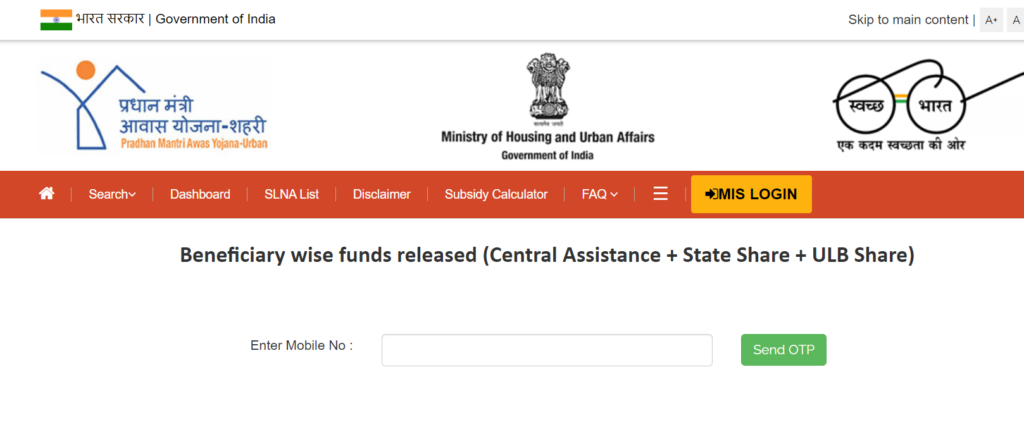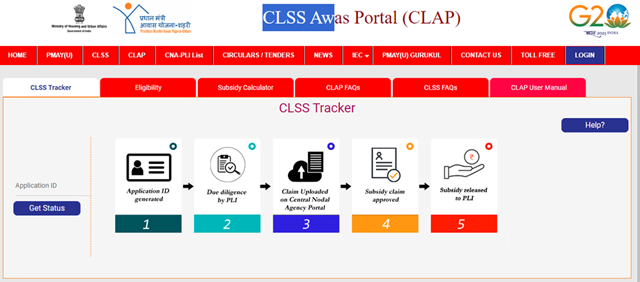The central government of India has announced the Pradhan Mantri Awas Yojana Urban 2.0. To provide housing facilities to all the financially unstable citizens of India who are living in urban areas the central government of India introduced the Pradhan Mantri Awas Yojana Urban 2.0. Under this scheme, the central government of India will provide financial help and other benefits to all the citizens who do not have a permanent house in India. All the citizens of India who belong to the EWS, LIG, and MIG segments Across India are the main targets of the authorities.

History of PMAY-U
The Pradhan Mantri Awas Yojana is one of the most glorious government schemes that was launched by the Prime Minister of India Mr Narendra Modi. The PMAY-U was first launched on 25th June 2015 for all the citizens of India. The vision of the central government of India before launching the scheme is “housing for all”. During the representation of the union budget 2024, the finance minister of India announced that the government of India will add 1 crore new houses under the PMAY-U 2.0. The one crore new houses will be built across India within an estimated time of 5 years.
Important Factors
| Name of Scheme | Pradhan Mantri Awas Yojana Urban 2.0 |
| Launched By | Central Government of India |
| Date of Launch | 25th June 2015 |
| Beneficiary | Homeless citizens |
| Objective of Scheme | Housing facilities |
| Nodal Department | Union Ministry of Housing and Urban Affairs |
| State | All States Of India |
| Benefits | Provide permanent houses |
| Mode of Application | Offline/online |
| Official Website | PMAYU website |
Objective
The main objective of launching the Pradhan Mantri Awas Yojana Urban 2.0 is to help all those citizens who cannot avail the benefits of the previous drive of the scheme. The government’s main purpose in launching this scheme is to significantly decrease the number of homeless people in India. The scheme will improve the quality of living among financially unstable citizens who do not have a permanent house. According to reports till now a total of 83.67 how is his are built by the central government of India. A total of 1.18 crore citizens have applied for the PMAY scheme.
Coverage Under PMAY Urban 2.0
- All legal towns/cities as per the government census of 2011 and towns notified consequently and areas falling under the boundary of Notified Planning Areas, Notified Planning/ Development area under the jurisdiction of Industrial Development Authority/Special Area Development Authority/Urban Development Authority or any such Authority under State legislation Which falls under the functions of urban planning and regulation will be included for the coverage of the PMAY Urban 2.0.
- The Cities/Towns and areas falling under Notified Planning Areas, Notified Planning/ Development areas under the jurisdiction of Industrial Development Authority/Special Area Development Authority/Urban Development Authority, or any such Authority, The scheme will continue to be implemented where it was previously implemented. All the towns and cities of India that were not a part of the PMAY Urban may also be included under the PMAY Urban 2.0 after getting approval from MoHUA.
Eligibility Criteria
- All the families who are permanent residents of India and belong to the EWS/LIG/MIG category, live in urban areas and have no pucca house anywhere in the country.
- The beneficiary who has been allotted a house under any of the housing schemes of the Central Government, State/UT Government, and Local self-government in the last 20 years in urban or rural areas, Will not be eligible to seek benefits under the scheme.
- For EWS households the citizens must have an annual income under INR 3 lakh.
- For LIG households the citizens must have an annual income between INR 3 lakh to 6 lakh
- For MIG households the citizens must have an annual income between INR 6 lakh to 9 lakh.
- According to the government special preference will be given to Widows, single women, Persons with Disabilities, Senior Citizens, Transgenders, persons belonging to Scheduled Castes/ Scheduled Tribes, Minorities, and other weaker and vulnerable sections of the society.
- The government will also make sure that if a pakka house has been provided to the parents of any beneficiary under the previous housing schemes then the beneficiaries will be considered only after other eligible beneficiaries whose parents have not availed of any benefit under the previous housing scheme are benefited.
- The houses sanctioned under PMAY-U which got curtailed by the Central Sanctioning and Monitoring Committee (CSMC) after 31.12.2023 due to any reason on the recommendation of States/UTs, shall not be sanctioned in PMAY-U 2.0 to those beneficiaries.
Silent Features
- Provide houses– The main and most important feature of the scheme is to provide permanent houses to all the homeless citizens of India.
- Another chance– With the help of the PMAY Urban 2.0 all those citizens who are left out from the previous drive due to any reason can apply for the scheme again to get their house.
- Decrease homelessness– By launching this initiative the Government of India wants to eliminate the problem of homelessness in India.
- 5 crore new houses- Under the PMAY Urban 2.0 the Government of India is all set to build a total of 5 crore new houses for 5 years.
Implementation Process
- The beneficiaries must register themselves for housing demand by filling out the application form on the web portal and entering all their detailed information.
- The beneficiaries will be checked by the States/UTs/ULBs as per the eligibility criteria of the scheme guidelines.
- States/UTs/ULBs should verify and exclude the beneficiary families from the list who is having a pucca house in a rural area and migrated to the city to take advantage of PMAY-U 2.0.
- According to the demand assessment and other accessible data, the cities will complete the online format of the city-wise housing plan on the web portal which includes the vertical-wise total and annual demand of housing for eligible beneficiaries in the city.
- The progress of houses constructed under the PMAY urban will be tracked through Geo-tagging at various stages and other digital norms so that each house can be monitored effectively at every stage of construction.
Verticals Under Pradhan Mantri Awas Yojana Urban 2.0
- Beneficiary Led Construction (BLC)
- Affordable Housing in Partnership (AHP)
- Affordable Rental Housing (ARH)
- Interest Subsidy Scheme (ISS)
Beneficiary Led Construction (BLC)
Under the VLC vertical of the scheme, the Government of India will provide financial assistance to individual households belonging to EWS categories to construct their new car house on their own available land. In the case of landless beneficiaries, the government will also provide them non-transferable land rights. The beneficiaries under this vertical may be allowed to construct a pucca house of a minimum of 30 sqm. and a maximum of 45 sqm. carpet area. The beneficiary must make sure that the new house has a combination of two rooms, a kitchen, and a toilet/bathroom. Enhancement and renovation of the existing house are not permissible under the Scheme.
Beneficiary Flow Chart
- Beneficiary
- Nonslum beneficiary/Belonging to slums not being taken up for redevelopment
- Verification of eligible beneficiaries by ULB ( Based on eligibility criteria )
- Preparation of project/ list of construction of new houses by ULB/ Implementing agencies
- Submission of project/ list
- Appraisal/approved by SLAC/ SLSMC
- Project submission for sanction of central assistance by CSMC
- Release of Central assistance through mandatory state shares.
Affordable Housing in Partnership (AHP)
The Affordable Housing in Partnership (AHP) Is the vertical of PMAY Urban 2.0 where the authorities will provide Central Assistance to EWS beneficiaries for owning a pucca house being built in different partnerships by States/UTs/ Cities/Private Agencies. Under this vertical, the government and private Agencies will build affordable houses of 30-45 sqm carpet area that will be given to the beneficiaries who belong to the EWS category. The government will build affordable houses on its own or by being in partnership with a private agency to increase the availability of affordable houses.
Construction of Houses by Public Sector Agencies
- The AHP projects under the Public Sector will be sanctioned only on encumbrance-free land supported with ownership documents submitted along with a Detailed Project Report (DPR).
- The detailed project report of the AHP project will be prepared by the implementing Agencies based upon the prevailing Schedule of Rate (SoR) and appraised by SLAC.
- The houses built under the project must promote diverse housing facilities including the areas of work and shelter ensuring livelihood opportunities.
- The state and union territories will also make sure to provide social Infrastructures like schools Healthcare green cover, and recreational facilities in the affordable housing areas.
- The central resistance for the building of infrastructure will be given in three installments in the ratio of 40:40:20 based on the progress of the projects.
Beneficiary Flow Chart
- AHP: Public projects by States/UT/ULBs
- Projects for EWS beneficiaries/ In-situ housing in “tenable slum”/ Resurtlement housing projects for “untenable slums”
- Preparation of comprehensive DPR
- Identification of eligible beneficiaries by ULB
- Sales price to be fixed by states/UTs
- Appraisal/approved by SLAC/ SLSMC
- Approval of RERA, NOCs, Time-bound approval, incentive
- Project submission for sanctioning of Central assistance by CSMC
- CSMC approval
- Release of Central assistant through mandatory state shares
Private sector AHP Projects
- According to the government, the AHP projects may be constructed by private developers on public-private partnership (PPP) more on their own encumbrance-free land with the following available options-
- A project exclusively for the EWS category
- The mixed housing project, if at least 25% of the houses in the project are for the EWS category and a single project has at least 100 houses.
- For projects of exclusive EWS category and mixed housing projects, the concerned developer must submit the project proposal along with the required details as per Annexure-5C to the concerned ULB for scrutiny.
- After approval, these projects will be considered as ‘Whitelisted Projects’ under PMAY-U 2.0 and now the developer is eligible to seek various financial incentives as mentioned in the scheme guidelines from the Government of India.
- To make the houses affordable for all the citizens belonging to EWS categories the states/UTs will decide on an upper ceiling on the sale price of houses of Whitelisted Projects in ‘rupees per square meter’ of carpet area.
Beneficiary Flow Chart
- AHP by private sector
- Exclusive Project for EWS by Private Developers/ Mixed Project (25% for EWS & single project of 100 houses).
- Submission of comprehensive DPR with checklist for whitelisting
- ULB/Implementing agency to scrutiny/review
- Appraisal/approval by SLAC/SLSMC /
- Sanctioning by CSMC for Whitelisting
- State/UT to upload whitelisted project on Unified Web portal
- Eligible beneficiary to register demand for whitelisted projects
- Verification of beneficiaries by ULB (as per scheme guidelines)
- Approval of eligible beneficiaries by SLSMC/CSMC
- Release of Redeemable Housing Voucher to beneficiaries (Central/State share)
- Redemption of Housing Voucher on occupancy of the purchased house
- Beneficiary to buy from private projects from the open market
- Eligible beneficiary to register demand for the desired project
- Verification of beneficiaries by ULB (as per scheme guidelines)
- Approval of eligible/verified beneficiaries by SLSMC/CSMC
- Release of Redeemable Housing Voucher to beneficiaries (Central/State share)
- Redemption of Housing Voucher on occupancy of the purchased house
Affordable Rental Housing (ARH)
The Affordable Rental Housing (ARH) vertical of PMAY Urban 2.0 will create a helpful environment by encouraging public/private entities to leverage investment for creating affordable rental housing facilities. It will promote the creation of adequate rental housing for EWS/LIG beneficiaries including urban migrants/homeless/destitute/industrial workers/working women/construction workers/, urban poor (street vendors, rickshaw pullers, other service providers etc.), migrants working with market/trade associations, educational/health institutions, hospitality sector, /contractual employees/ amongst others.
Converting existing Government funded vacant houses into ARH
- The state and UTs have the right to use constructed houses that are still lying vacant and unutilized that are built by the central state or union territory government scheme to provide houses.
- The authorities can repair and renovate the house along with necessary civic infrastructure facilities by themselves or through a concessionaire, after all the work these houses will be given to the beneficiaries under the PMAY urban 2.0.
- The required investment for the repair and renovation of the houses will have to be made by the States/UTs/ULB/ dealers from their own financial sources which would be recovered through rental income.
- The initial rent of the houses under ARH will be set by the local authorities based on the survey. Every 2 years, the authorities will increase the rent by 8% but in any case, the rent cannot be increased by more than 20% in 5 years.
Beneficiary Flow Chart
- Converting existing Government funded vacant houses
- Creation of Inventory of vacant Projects/Houses by States/UTs/ULBs
- Project-wise estimation for repair/retrofit, infrastructure development by States/UTs/ULBs
- Fixation of affordable rent through Local Survey by States/UTs/ULBs
- Issuance of Request for Proposal (RFP) by ULB
- Selection of Concessionaire for operation and maintenance
- SLSMC Approval & presentation to CSMC for information and record
- Projects details to be entered on Unified web portal
- Repair/Retrofit & Gap filling of Infrastructure by Concessionaire
- Operation and Maintenance by Concessionaire & Profit Sharing with State/UT/ULB
- Handover the project to State/UT/ULB after the contract period
- ULB to restart the next cycle like earlier or operate the ARH on their own
Construct, Operate and Maintain Rental housing by Private/Public Entities
- The public-private entities have the right to construct, operate and maintain ARH to provide accommodation to eligible EWS/LIG families. The entities may also use ARH as housing facilities for their employees and workers.
- The minimum size of dwelling units of a single or double bedroom and dormitories shall confirm to the requirement of National Building Code and state/local norms.
- The entities will fix the rent of the ARH projects based on the local survey conducted by the authorities. Subsequently, rent will be enhanced every two by a maximum of 8%.
- The entities themselves or by hiring any associated organization can organize point-to-point transport facilities. Expenditure for the facility can be recovered from the tenants at an affordable rent rate.
Beneficiary Flow Chart
- Construct, Operate and Maintain Rental housing by Private/Public Entities
- Issuance of Expression of Interest (EOI) by MoHUA.
- Submission of Detailed Project Report (DPR) by shortlisted entities to ULB (Urban Local Body).
- Review and Statutory Approval by ULB and recommendation to the state for listing the project as ARH (Affordable Rental Housing).
- State-Level Sanctioning and Monitoring Committee (SLSMC) Approval and listing the project under ARH for providing incentives to entities.
- If No, the process:
- The State/UT notifies ULB for implementation of ARH.
- The entity implements the project and operates and maintains ARH for EWS/LIG (Economically Weaker Sections/Low-Income Groups).
- If Yes, the process:
- Project details are entered on the Unified Web Portal.
- State sends SLSMC-approved proposals to MoHUA for appraisal by BMTPC (Building Materials and Technology Promotion Council).
- BMTPC appraises the proposal and recommends to CSMC (Central Sanctioning and Monitoring Committee) for approval.
- Approval of the proposal/TIG (Technology Innovation Grant) by CSMC.
- TIG released to the entity in three installments by MoHUA after approval of the state/UT/BMTPC, as per scheme guidelines.
- Technical Assistance and project monitoring by State/UT/BMTPC.
Interest Subsidy Scheme (ISS)
The interest subsidy scheme is the principle of the PMAY Urban 2.0 that expands institutional credit flow to the affordable housing sector. Under this vertical the Government of India will provide subsidy will be provided on home loans sanctioned and disbursed on 01.09.2024 or after to eligible beneficiaries of EWS, LIG, and MIG for purchase/ re-purchase/construction of houses. All the citizens of India who belong to the EWS, LIG, and MIG households and have an annual income of less than INR 3 lakhs, 6 lakhs, and 9 lakhs respectively are eligible to avail the benefits.
Beneficiary Flow Chart
- Interest Subsidy Scheme (ISS)
- Entry of demand survey by citizen and selection of PLIs (Primary Lending Institutions) for a home loan.
- Validation and de-duplication check.
- Declaration required on:
- Status of house in India.
- Benefits availed under any housing schemes in the last 20 years.
- Annual household income.
- Generation of unique application ID.
- Forwarding of the application to concerned PLIs for processing.
- PLIs perform:
- Due diligence.
- Verification.
- Documentation.
- If PLIs reject the application:
- Intimate the applicant with rejection reason.
- If PLIs accept the application:
- Geo-tagging of house by PLI/beneficiary.*
- Uploading of claim by PLI within 30 days of loan disbursement.
- Sharing approved claims with the Ministry.
- If the claim is rejected during CNA re-validation:
- Sent back to the PLI through the Ministry for clarification.
- If the claim is accepted:
- Subsidy credited directly to the beneficiary’s loan account.
- Subsidy released by MoHUA (Ministry of Housing and Urban Affairs).
- SMS to the beneficiary with the beneficiary code.
- Subsequent subsidy release after validation by PLI.
PMAY Urban 2.0 Funding Pattern
| States/UTs | BLC & AHP | ARH | ISS |
| Assam, Arunachal Pradesh, Meghalaya, Manipur, Mizoram, Nagaland, Tripura, Sikkim, Himachal Pradesh, Uttarakhand, UTs of Jammu and Kashmir, Puducherry and Delhi | Central Govt. – ₹2.25 lakh/Unit State Govt. – Min. ₹0.25 lakh/Unit | Technology Innovation Grant Central Govt. – ₹3,000/sqm per unit State Govt.- ₹2,000/sqm per unit | Home Loan Subsidy – up to ₹1.80 lakh (Actual Release) per unit by Government of India as Central Sector Scheme |
| All other UTs | Central Govt. – ₹2.50 lakh/Unit | ||
| All other states | Central Govt. – ₹1.5 lakh/Unit State Govt. – Min. ₹1.00 lakh/Unit |
Fund Release Process
- The central resistance under the BLC, AHP, and ARH will be released by the authorities after the approval of CS MC with the occurrence of the Integrated Finance Division (IFD) of the ministry.
- The central resistance under BLC, AHP, and ARH will be released in 3 installments of 40%, 40%, and 20%.
- A provision for a Fund Transfer Order (FTO) will be made in MIS for tracking the actual status of fund release to the beneficiary under the BLC vertical which shall be integrated with the Geotagging stages.
- The central assistance will be given to all the state or UTs on the basis of the work done on the project.
Pradhan Mantri Awas Yojana Urban 2.0 Apply Online
STEP 1: All the citizens of India who want to avail the benefits of the Pradhan Mantri Awas Yojana Urban 2.0 are requested to visit the official PMAY website.

STEP 2: Once the citizens reach the home page of the official website they must locate and click on the option called “Citizen Assessment“.

STEP 3: A new page will appear on your desktop screen where citizens must enter their Aadhar Card and virtual ID and click on the option “Check“.
STEP 4: Now the citizens will be redirected to the application form page where the citizens must enter all the details that are asked and attach all the necessary documents.
STEP 5: After entering all the details the citizens must quickly review it and click on the option “submit” to complete their process.
Search Beneficiary
STEP 1: All the citizens who have already applied for the Pradhan Mantri Awas Yojana Urban 2.0 are requested to visit the official website to search for beneficiaries online.
STEP 2: Once the citizens reaches the home page of the official website they must locate and click on the option called “PMAY(U)MIS” available on the dashboard.

STEP 3: On the new page the citizens can click on the option “search beneficiary” and enter the mobile number.

STEP 4: After entering their mobile number the citizens must click on the option “send OTP” and enter the OTP that have received on the registered mobile number.
STEP 5: Now the beneficiary details will appear on your desktop screen.
Check Application Status
STEP 1: All the citizens who have already applied for the Pradhan Mantri Awas Yojana Urban 2.0 are requested to visit the official website to search for beneficiaries online.
STEP 2: Once the citizens reach the home page of the official website they must locate and click on the option called “CLAP” available on the dashboard.

STEP 3: On the new page the citizens can click on the option “search beneficiary” and enter the mobile number.

STEP 4: Now the citizens must scroll down enter the application ID, and then click the “Get Status” option to complete their process.
Contact Details
- pmaymis-mhupa@gov[Dot]in
FAQs
Who is eligible to avail the benefits of the Pradhan Mantri Awas Yojana Urban 2.0?
All the homeless citizens of India who do not own permanent houses are eligible to avail the benefits of the Pradhan Mantri Awas Yojana Urban 2.0.
What is the main purpose of launching the Pradhan Mantri Awas Yojana Urban 2.0?
The main purpose of launching the Pradhan Mantri Awas Yojana Urban 2.0 is to provide houses to all those citizens who are left out after the first drive of the scheme.
When was the Pradhan Mantri Awas Yojana Urban 2.0 launched?
The Pradhan Mantri Awas Yojana Urban 2.0 was launched on 25th June 2015.
What is the nodal department that is administrating the works of Pradhan Mantri Awas Yojana Urban 2.0?
The Union Ministry of Housing and Urban Affairs is the nodal department that is administrating the works of Pradhan Mantri Awas Yojana Urban 2.0.
